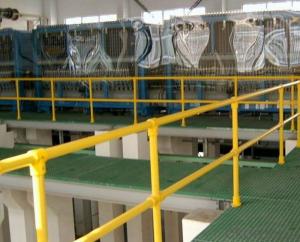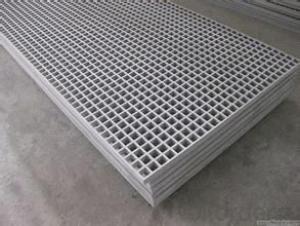FRP grating full colours as your requirement with insulation
- Loading Port:
- Shanghai
- Payment Terms:
- TT OR LC
- Min Order Qty:
- 10 pc
- Supply Capability:
- 8000 pc/month
OKorder Service Pledge
OKorder Financial Service
You Might Also Like
Specification:
FRP molded grating made of vertical and horizontal continuous fiberglass fully soaked in unsaturated polyester resin giving perfect bi-directional mechanical properties. Combining unmatched corrosion resistance with strength, long life and safety, molded grating provide the ultimate in reliable performance, even in the most demanding corrosive conditions. Besides, it is easy to cut and install. CNBM offer the widest selection with panel sizes, colors and slip resistant surfaces, clients can avail FRP grating your specific requirements.
Product Features:
- Light but high loaded strength
- High anti-corrosion and anti-aging
- Easy installation and maintenance
- Low maintenance
- Non-conductive
- Lowest in life cycle cost
- Corrosion Resstance
- Anti-slippery
- Various sizes and color available
Colour Design:
To satisfy customer's design project, CNBM grating offers a wide selection of grating colors to choose from. The standard colors available for fiberglass grating as following:
- Blue
- Red
- Yellow
- Green
- Light Grey
- Dark Grey
Custom colors of fiberglass grating may be available upon request, you can contact us learn more.
Moded Grating Sizes List:
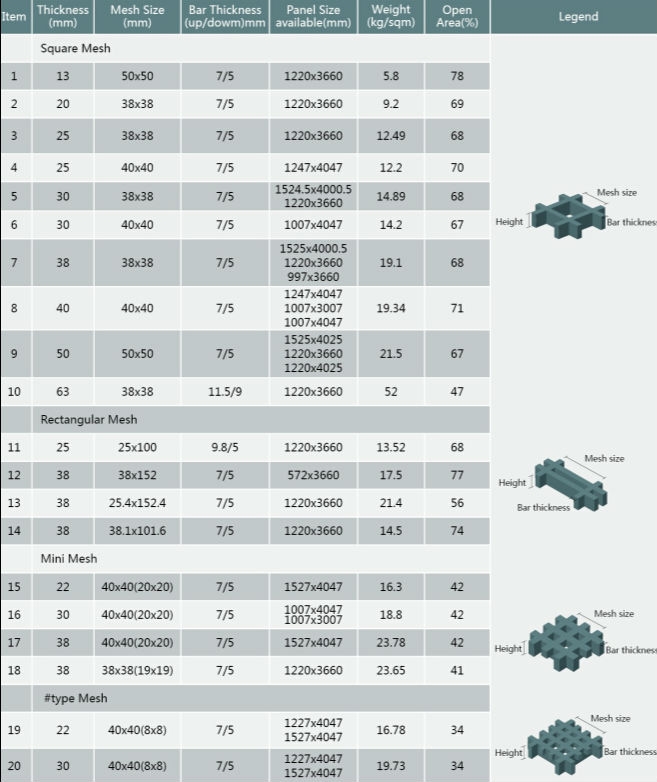
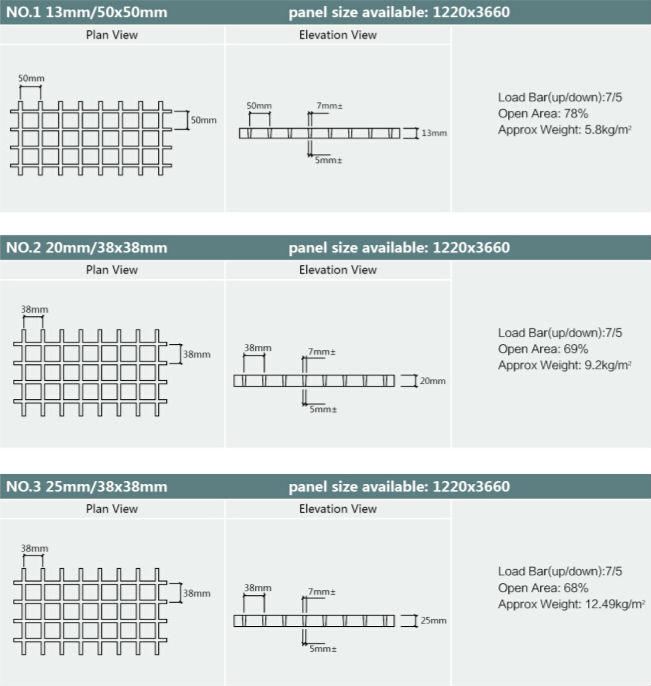

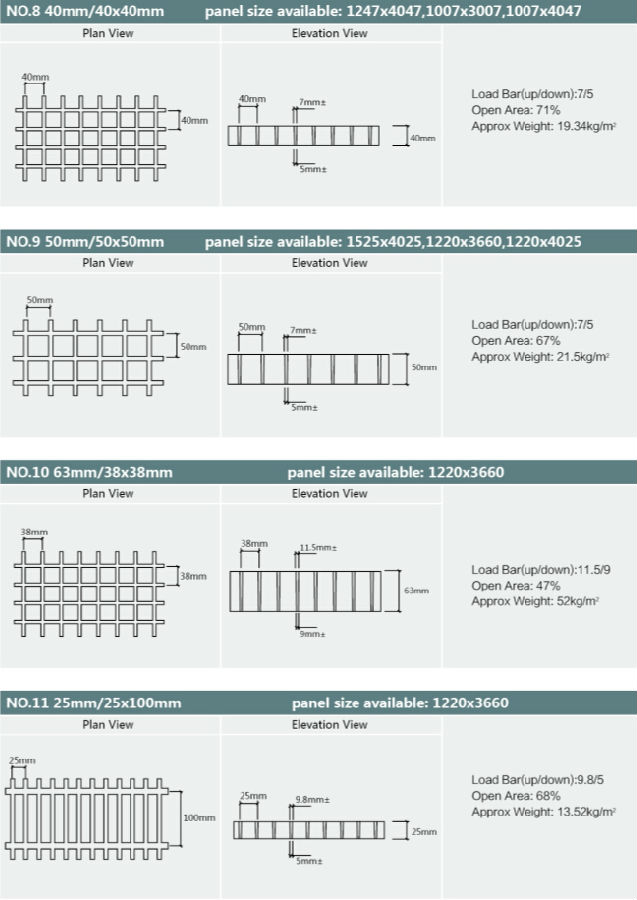
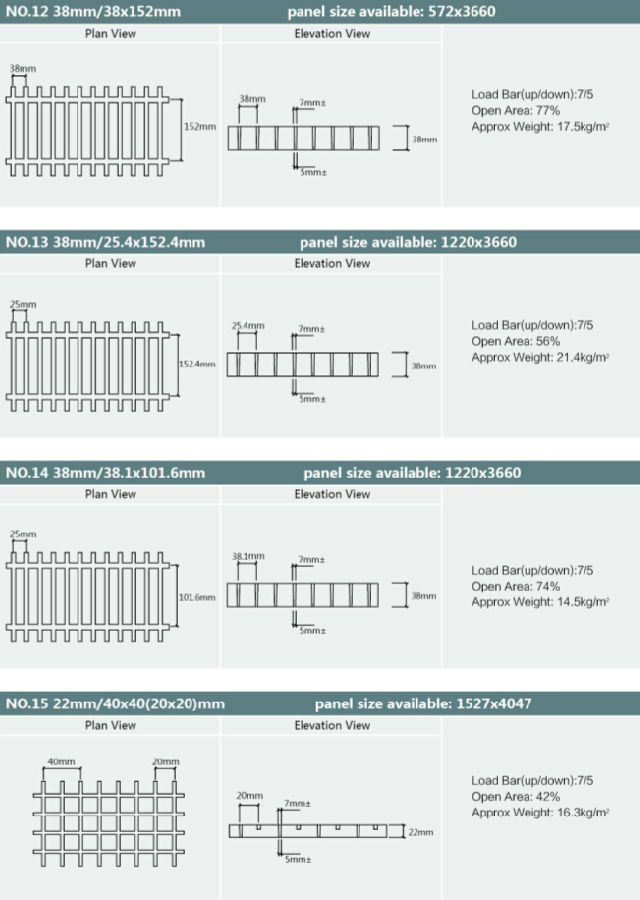
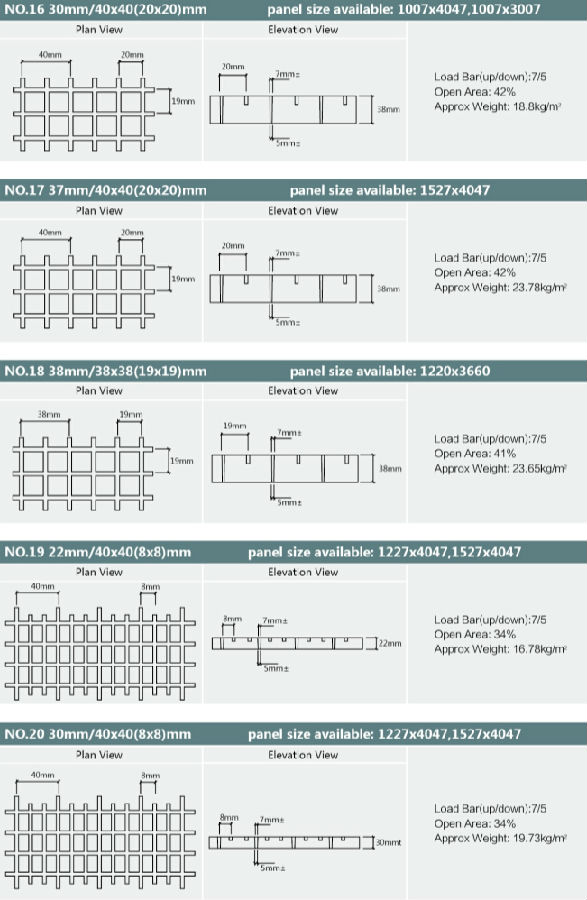
- Q:Can FRP pultrusion profiles be used in the construction of wind turbine blades?
- Indeed, FRP pultrusion profiles have the capability to be utilized in the construction of wind turbine blades. There are several advantages offered by FRP pultrusion profiles that render them suitable for this purpose. To begin with, FRP pultrusion profiles possess a lightweight yet robust nature, a crucial characteristic for wind turbine blades since they must endure the aerodynamic forces exerted by the wind. The high strength-to-weight ratio of FRP pultrusion profiles permits the creation of longer and more effective blades. Moreover, FRP pultrusion profiles exhibit exceptional corrosion resistance properties, a vital attribute for wind turbines that are exposed to harsh weather conditions. In contrast to traditional materials like steel, FRP does not corrode, thereby ensuring an extended service life for the wind turbine blades. Additionally, FRP pultrusion profiles are customizable to satisfy specific design requirements. This flexibility allows for the optimization of blade performance by tailoring the shape, thickness, and stiffness of the profiles to maximize energy capture and minimize fatigue. Furthermore, FRP pultrusion profiles possess good fatigue resistance, enabling them to endure repeated loading cycles without experiencing significant performance degradation. This is particularly crucial for wind turbine blades, which encounter cyclic loading due to wind gusts and changes in wind direction. Lastly, FRP pultrusion profiles are electrically non-conductive, a beneficial trait for wind turbine blades as it eliminates the risk of electrical discharge during operation. In conclusion, the lightweight, strong, corrosion-resistant, and customizable nature of FRP pultrusion profiles makes them an outstanding choice for the construction of wind turbine blades. This contributes to the advancement of more efficient and durable wind energy systems.
- Q:Are FRP pultrusion profiles suitable for the manufacturing of chemical reactors?
- Yes, FRP pultrusion profiles are suitable for the manufacturing of chemical reactors. FRP (Fiber Reinforced Polymer) pultrusion profiles offer excellent resistance to corrosion, high strength-to-weight ratio, and dimensional stability, making them ideal for use in chemical reactors. Additionally, FRP materials can withstand a wide range of chemical environments and temperatures, making them a reliable choice for this application.
- Q:What are the best manufacturers of glass fiber reinforced plastic pultruded profiles in China?
- Glass fiber reinforced plastic 1.5mm really can not do, I suggest you do PVC, PP or ABS profiles, the same corrosion resistance.
- Q:Are FRP pultrusion profiles resistant to caustic soda?
- FRP pultrusion profiles are generally immune to caustic soda, which is a potent alkaline substance capable of corroding certain materials. However, FRP pultrusion profiles consist of robust fibers (like fiberglass) combined with a resin matrix (such as polyester or epoxy). This composite construction renders them highly resistant to chemicals, including caustic soda. Consequently, FRP pultrusion profiles find extensive application in industries prone to exposure to corrosive substances, such as chemical processing, wastewater treatment, and mining. It is worth noting that the choice of resin in the FRP profiles, along with the concentration and temperature of the caustic soda, can impact the overall level of resistance.
- Q:Can FRP pultrusion profiles be used in the production of electrical cabinets?
- Yes, FRP (Fiber Reinforced Polymer) pultrusion profiles can definitely be used in the production of electrical cabinets. FRP pultrusion profiles have excellent electrical insulating properties, making them a suitable choice for applications involving the production of electrical cabinets. These profiles are non-conductive and can provide insulation and protection against electrical currents, ensuring the safety of the electrical components housed within the cabinet. Additionally, FRP pultrusion profiles offer high strength-to-weight ratio, corrosion resistance, and durability, making them a reliable choice for long-lasting electrical cabinets in various environments.
- Q:Can FRP pultrusion profiles be used in the construction of modular buildings?
- Modular buildings can utilize FRP (Fiber Reinforced Polymer) pultrusion profiles. These profiles possess various advantages that render them suitable for modular construction. To begin with, FRP pultrusion profiles are not only lightweight, but also highly durable and strong. This makes them perfect for modular buildings, where reducing weight is crucial for transportation and assembly. In fact, the strength-to-weight ratio of FRP pultrusion profiles often surpasses that of traditional construction materials like steel or concrete. Furthermore, these profiles are resistant to corrosion, chemicals, and weathering. This becomes particularly significant for modular buildings, as they may face different environmental conditions during transportation and on-site assembly. The corrosion resistance also guarantees the longevity and durability of the modular building. Moreover, FRP pultrusion profiles can be designed to possess excellent thermal insulation properties. This proves advantageous for modular buildings that prioritize energy efficiency, as it helps minimize heating and cooling costs. Additionally, these profiles are easily shaped and customized to meet the specific requirements of the modular building design. This versatility allows for the creation of intricate and complex structural components, thereby facilitating the modular construction process. Furthermore, FRP pultrusion profiles are non-conductive, which enhances safety in modular buildings. Their inability to conduct electricity makes them appropriate for applications necessitating electrical insulation. In conclusion, FRP pultrusion profiles offer a viable choice for constructing modular buildings due to their lightweight, durability, corrosion resistance, thermal insulation properties, versatility, and non-conductive nature. These attributes make FRP pultrusion profiles a reliable and efficient solution for modular construction projects.
- Q:Can FRP pultrusion profiles be used in agricultural structures?
- Agricultural structures can indeed utilize FRP pultrusion profiles. FRP pultrusion profiles, also known as Fiber Reinforced Polymer profiles, possess numerous advantages that render them suitable for agricultural purposes. To begin with, the corrosion resistance of FRP profiles is of utmost importance in the agricultural industry, given the exposure of structures to harsh environments and chemicals like fertilizers and pesticides. Unlike conventional materials such as steel or wood, FRP does not rust or decay, ensuring enduring performance in agricultural structures. Furthermore, FRP profiles are lightweight yet durable, facilitating easy handling and installation in agricultural applications. Their high strength-to-weight ratios enable efficient construction, thereby reducing the necessity for heavy machinery during the installation process. Moreover, FRP profiles exhibit exceptional mechanical properties, including high stiffness and impact resistance, which prove advantageous for agricultural structures subjected to heavy loads, vibrations, or machinery impact. In addition, FRP pultrusion profiles can be designed to resist UV radiation, thereby preventing degradation from prolonged exposure to sunlight. This quality makes them suitable for outdoor agricultural structures consistently exposed to the elements. Lastly, FRP profiles are non-conductive, a critical advantage in agricultural environments where electrical safety is paramount. This characteristic eliminates the risk of electrical hazards associated with conductive materials like steel. In summary, FRP pultrusion profiles offer a reliable and efficient solution for a variety of agricultural structures, such as greenhouse frames, livestock enclosures, irrigation systems, and storage facilities. Their corrosion resistance, lightweight nature, high strength, UV resistance, and non-conductivity make them an ideal choice for agricultural applications.
- Q:What are the features of Glass Fiber Reinforced Plastic Pultruded materials and chairs?
- Glass reinforced plastic extruded section bar has the characteristics of unlimited length, high utilization rate of raw material, corrosion resistance, good weatherability and long service life
- Q:Are FRP pultrusion profiles resistant to alkalis?
- Yes, FRP pultrusion profiles are generally resistant to alkalis.
- Q:Are FRP pultrusion profiles resistant to chemicals used in agricultural applications?
- Yes, FRP (Fiber Reinforced Polymer) pultrusion profiles are highly resistant to chemicals used in agricultural applications. FRP pultrusion profiles are made from a combination of reinforced fibers and a polymer resin matrix, typically polyester or vinyl ester. These materials provide excellent resistance to a wide range of chemicals commonly used in agriculture, such as fertilizers, pesticides, herbicides, and various acids. The inherent corrosion resistance of FRP pultrusion profiles makes them a preferred choice in agricultural applications where exposure to chemicals is common. Unlike traditional materials like wood, steel, or concrete, FRP profiles do not deteriorate or degrade when exposed to aggressive chemicals. This resistance ensures that the profiles maintain their structural integrity and performance over a long lifespan, even under harsh agricultural conditions. Furthermore, FRP pultrusion profiles offer superior resistance to corrosion, moisture, UV radiation, and temperature fluctuations. These properties make them highly durable and suitable for a wide range of agricultural applications, including structural supports, fencing, grating, decking, and irrigation systems. It is important to note that while FRP pultrusion profiles are highly resistant to chemicals, they may still experience some level of degradation or staining when exposed to extremely concentrated or highly aggressive chemicals. Therefore, it is recommended to consult with the manufacturer or supplier to ensure that the specific chemicals used in the agricultural application are compatible with the chosen FRP pultrusion profiles.
1. Manufacturer Overview |
|
|---|---|
| Location | |
| Year Established | |
| Annual Output Value | |
| Main Markets | |
| Company Certifications | |
2. Manufacturer Certificates |
|
|---|---|
| a) Certification Name | |
| Range | |
| Reference | |
| Validity Period | |
3. Manufacturer Capability |
|
|---|---|
| a)Trade Capacity | |
| Nearest Port | |
| Export Percentage | |
| No.of Employees in Trade Department | |
| Language Spoken: | |
| b)Factory Information | |
| Factory Size: | |
| No. of Production Lines | |
| Contract Manufacturing | |
| Product Price Range | |
Send your message to us
FRP grating full colours as your requirement with insulation
- Loading Port:
- Shanghai
- Payment Terms:
- TT OR LC
- Min Order Qty:
- 10 pc
- Supply Capability:
- 8000 pc/month
OKorder Service Pledge
OKorder Financial Service
Similar products
New products
Hot products
Hot Searches
Related keywords
